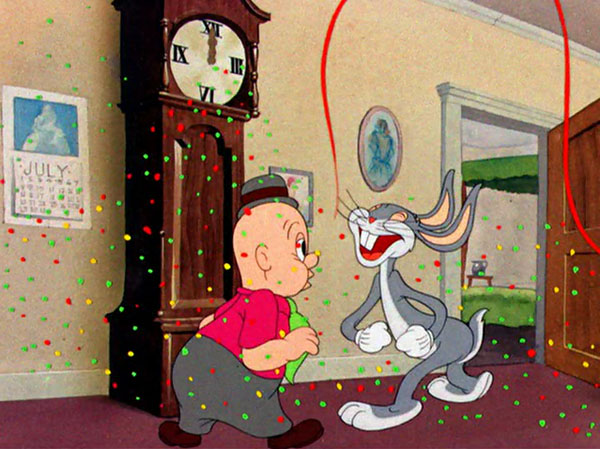
from “The Wabbit Who Came To Supper” (1942)
I have no idea how many of you may be taking time away from your New Year’s celebrations to check out this site – but I know that if all computer systems are go, this article may be appearing precisely at the stroke of midnight (Pacific Time). So, if possible, let me the first to wish the hardy few of you who are the first to read this post – HAPPY NEW YEAR!!!!! For all you latecomers – well, there’s still plenty of cheer below to fill up your new day of festivities (if you can tear yourself away from all those football games!)
All the clocks are ringing in celebration. From Big Ben down to microchip timers. Let’s mosey along with Father Time through the end of the present trail, and follow the later entries in animation’s love-affair with clockwork up through the present day.
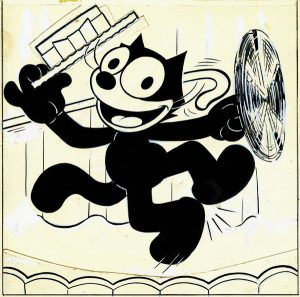 Stone Age Felix, an episode of the television version of Felix the Cat from about 1960, appears to be the only episode of the series that attempts to adapt to modern form ideas from two Pat Sullivan silent Felixes of the 1920’s – Felix Trifles With Time, discussed in part one of this article, and Felix In the Bone Age (12/15/22), In this reworking, Felix awakes to his alarm clock, complaining that it seemed like a short rest, then realizing he’s got to hurry to make it to work. Racing through morning routine, he arrives at work only one minute late – and is promptly fired, and booted out an upper story window. Landing on the street below, he observes traffic, fire and police vehicles zipping past, and jets streaming through the sky. He remarks to the audience that time is moving too fast to suit him, and that at this rate, he’ll be old before he knows it (illustrated by images of him with a progressively-growing white beard). On his way home, he passes a large building with numerous clock faces upon it. Looking through the window, he discovers it’s the work station of Father Time, who kicks at a master time mechanism, pushing it into gear to go “faster”. Deciding that Time is the one to blame for all of Felix’s troubles, Felix sneaks into the building while Father Time takes a break in an easy chair. Felix pulls on the master control in attempt to shift it to slow – but pulls too far, jamming the machine into “Reverse” gear. Father Time awakens, but realizes that with time going backwards it’s too late for him to do anything about it – as he rapidly shrinks down to a baby. Felix runs, but the years roll rapidly backward past him, as he meets wild West Indians, Benjamin Franklin, a knight in armor, and finally finds himself in the stone age.
Stone Age Felix, an episode of the television version of Felix the Cat from about 1960, appears to be the only episode of the series that attempts to adapt to modern form ideas from two Pat Sullivan silent Felixes of the 1920’s – Felix Trifles With Time, discussed in part one of this article, and Felix In the Bone Age (12/15/22), In this reworking, Felix awakes to his alarm clock, complaining that it seemed like a short rest, then realizing he’s got to hurry to make it to work. Racing through morning routine, he arrives at work only one minute late – and is promptly fired, and booted out an upper story window. Landing on the street below, he observes traffic, fire and police vehicles zipping past, and jets streaming through the sky. He remarks to the audience that time is moving too fast to suit him, and that at this rate, he’ll be old before he knows it (illustrated by images of him with a progressively-growing white beard). On his way home, he passes a large building with numerous clock faces upon it. Looking through the window, he discovers it’s the work station of Father Time, who kicks at a master time mechanism, pushing it into gear to go “faster”. Deciding that Time is the one to blame for all of Felix’s troubles, Felix sneaks into the building while Father Time takes a break in an easy chair. Felix pulls on the master control in attempt to shift it to slow – but pulls too far, jamming the machine into “Reverse” gear. Father Time awakens, but realizes that with time going backwards it’s too late for him to do anything about it – as he rapidly shrinks down to a baby. Felix runs, but the years roll rapidly backward past him, as he meets wild West Indians, Benjamin Franklin, a knight in armor, and finally finds himself in the stone age.
He is pursued by a brontosaurus. Felix ducks through a small hole in a rock wall. The bronto sticks his head through, and Felix tosses a boulder into his mouth, which he swallows – trapping the bronto’s neck so he can’t pull it out of the hole (a similar gag was used in Warner Brothers’ The Rattled Rooster (6/26/48), with swallowed golf balls to trap a snake in a fence). Felix is next chased up a tree by a fire-breathing lizard, who uses its serrated scaly tail to saw down the limb of Felix’s tree, only to get pinned to the ground by the falling limb. Another dino nearly eats Felix while consuming another tree Felix climbs. Then (borrowed from “Bone Age”), Felix encounters a caveman trying to please his girlfriend with a new fur, but she doesn’t care for the usual saber-toothed tigers, and wants something more sporty – pointing at Felix! Felix hides in a mound of dirt. “Caddy, my clubs”, calls the caveman. A boy brings in a bag full of wooden clubs, one of which the caveman uses to take aim at the mound and golf Felix out of the dirt. Felix appears trapped inside a rock enclosure, but sneaks out a small hole to grab the caveman’s club from behind and knock him out. But another, more fierce looking caveman, and a mammoth, surround Felix from both sides, and he is cornered. At this crucial moment, the scene dissolves back to Felix’s bedroom, with the alarm clock ringing. Felix throws something at the clock to silence it, and says, “Boy, what a dream!” He settles back into bed, pulling the covers up. “Who cares about time? It’s Saturday!”. he states with a wink for a curtain line, and falls asleep.
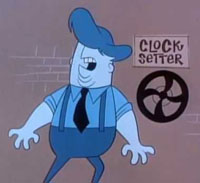
“Tick Tock Shock”
Cuckoo Magoo, from The Mister Magoo Show, is also unavailable from the internet, except for a brief plot description that indicates Magoo attempts to take a cuckoo clock into town to get fixed, but gets mistaken for a mad bomber.
Tick Tock Shock, from UPA’s The Dick Tracy Show, is yet another absentee from internet review. A brief plot description indicates its hero is Heap O’Calorie, and its villains The Brow and Oodles, trying to steal jeweled settings off a tower clock.
 Bats in the Belfry (Lantz/Universal, Woody Woodpecker, 7/13/60 – Paul J. Smith, dir.) – A wealthy Colonel, owner of a palatial estate, has developed an allergy to noise, particularly from repeated exposure to the clangs of a giant bell in a nearby clock tower. Whenever it strikes, the Colonel goes into a severe case of vibration jitters (in a series of drawings Smith must have liked, as he repeated it in several later episodes, placing the Colonel into multiple photographic exposures so that in some frames he appears to have about ten eyes). A doctor (practically a Wally Walrus type) instructs Butler Jeeves to make sure there is “no noise’. Of course, enter our noisy red-headed star to peck on a tree. The battle lines are drawn between Jeeves and Woody, the latter of whom repeated gets the bum’s rush from the Butler. But Woody catches on about the effects of the tower clock on Jeeves’ master, and while Jeeves is sent to silence the clock, Woody manipulates the clock hands to repeatedly make the clock strike the hour. Jeeves is forced to play the game of dodging the mallet of a mechanical clock figure similar to Disney’s Clock Cleaners designed to strike the bell, and usually gets whacked in the head himself – especially when Woody substitutes a five-times-bigger mallet in the figure’s hand. Woody then removes one of the clock’s main gears and sends its hands spinning haywire, so the bellringer figure will repeatedly appear.
Bats in the Belfry (Lantz/Universal, Woody Woodpecker, 7/13/60 – Paul J. Smith, dir.) – A wealthy Colonel, owner of a palatial estate, has developed an allergy to noise, particularly from repeated exposure to the clangs of a giant bell in a nearby clock tower. Whenever it strikes, the Colonel goes into a severe case of vibration jitters (in a series of drawings Smith must have liked, as he repeated it in several later episodes, placing the Colonel into multiple photographic exposures so that in some frames he appears to have about ten eyes). A doctor (practically a Wally Walrus type) instructs Butler Jeeves to make sure there is “no noise’. Of course, enter our noisy red-headed star to peck on a tree. The battle lines are drawn between Jeeves and Woody, the latter of whom repeated gets the bum’s rush from the Butler. But Woody catches on about the effects of the tower clock on Jeeves’ master, and while Jeeves is sent to silence the clock, Woody manipulates the clock hands to repeatedly make the clock strike the hour. Jeeves is forced to play the game of dodging the mallet of a mechanical clock figure similar to Disney’s Clock Cleaners designed to strike the bell, and usually gets whacked in the head himself – especially when Woody substitutes a five-times-bigger mallet in the figure’s hand. Woody then removes one of the clock’s main gears and sends its hands spinning haywire, so the bellringer figure will repeatedly appear.
A montage of shots displays Jeeves getting repeatedly clunked, while Woody and the mechanical figure continue to freely have their way with the bell. The scene dissolves to a later time. Somehow, despite the noise, the Colonel has made a recovery, on which the doctor is congratulating him. The Colonel calls for Jeeves to serve tea. As Jeeves enters, the clock tower bell goes off again. Jeeves instantly falls under the identical type of vibration fit the Colonel previously suffered. The Colonel thinks he’s “balmy” – but the next clock bong sends the Colonel back into his old fits too. “Ooh, that stuff is catching”, concludes the doctor, and himself goes into fits on the third chime. Out in the garden, Woody laughs, “Well, what do you know”, until he too jitters at the fourth bong. Borrowing a leaf from the ending of Tex Avery’s earlier Lantz classic, Crazy Mixed Up Pup, the running gag spills over into the end credits, with the letters “The End” going into the jitters as one last clang is heard from the tower. (Note: When Castle Films released this film to home movies, they missed their cue in a piece of bad judgment. Up to the time of this release, Lantz cartoons in their catalog had for many years retained their theatrical end-titles. For unknown reasons, Castle changed practice at the time this title was issued, substituting their own logo for the ending, and losing entirely the integrated title gag. Would it have killed them to let one more title slip through uncut before changing policy? )
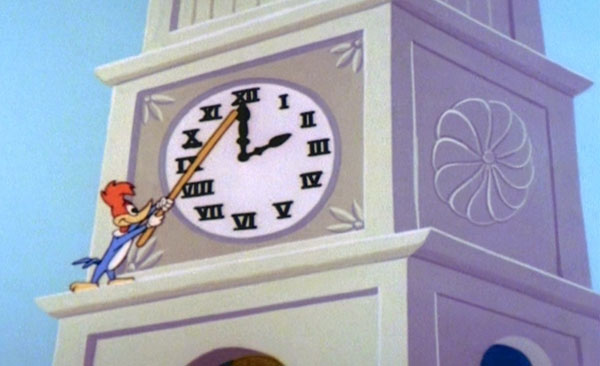
Without Time Or Reason (Paramount, Noveltoon, 1962 – Seymour Kneitel, dir., Eddie Lawrence, story), inaugurated a brief period of new creativity at Paramount Cartoon Studios, with the arrival of comedian Eddie Lawrence, fresh off the popularity of a good-selling series of comedy recordings for Coral records, including his signature routine, “The Old Philosopher” (“Is that your problem, Bunky?”) Rather than merely try to turn the Philosopher character into a cartoon, Eddie was encouraged to create a new set of characters as a comedy team, to which he would provide both the voices. The result was a fast-talking New York humored duo who would come to be known as Swifty and Shorty (though they were nameless in this first episode, and in their second appearance would go by the names of Ralph and Percy).
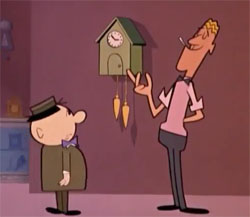 Our scene opens in a clock store, with mild-mannered Shorty entering with an old pocket watch. Swifty, a wise cracking saleman/repairman, works behind the counter. Upon seeing Shorty, he cautions him not to stare at the merchandise, hiding from him the clock he is repairing. “Why, what did I do?” asks Shorty. Swifty replies, “It’s faces like yours that stop a clock.” Shirty asks to have the crystal repaired in his watch, an antique heirloom with animated marching figures of the “Spirit of ‘76″ patriots. Swifty scoffs at the timepiece as “passe….It’s still got twelve numbers on it.” He begrudgingly agrees to repair it, but insists that Shorty should get something new. Shorty is talked into looking a clocks, and for the 30 bucks he has on hand, Swifty offers him a cuckoo clock on special discount – because the cuckoo’s dead. But Swifty offers to replace it with a baby eagle for an extra 10 dollars. Shorty questions how the miniature bird is going to wake him up, noting that he’s a sound sleeper who usually doesn’t wake up without a cold shower, Swifty insists the bird will grow bigger, and will lift him out of bed into the shower with powerful talons. He proves his point by having the bird clamp his claws firmly into Shorty’s nose. “But I only got 30 dollars”, says Shorty. “That’s all right, I trust ya”, replies Swifty. “But you got my watch”, says Shorty. “That’s why I trust ya”, replies Swifty.
Our scene opens in a clock store, with mild-mannered Shorty entering with an old pocket watch. Swifty, a wise cracking saleman/repairman, works behind the counter. Upon seeing Shorty, he cautions him not to stare at the merchandise, hiding from him the clock he is repairing. “Why, what did I do?” asks Shorty. Swifty replies, “It’s faces like yours that stop a clock.” Shirty asks to have the crystal repaired in his watch, an antique heirloom with animated marching figures of the “Spirit of ‘76″ patriots. Swifty scoffs at the timepiece as “passe….It’s still got twelve numbers on it.” He begrudgingly agrees to repair it, but insists that Shorty should get something new. Shorty is talked into looking a clocks, and for the 30 bucks he has on hand, Swifty offers him a cuckoo clock on special discount – because the cuckoo’s dead. But Swifty offers to replace it with a baby eagle for an extra 10 dollars. Shorty questions how the miniature bird is going to wake him up, noting that he’s a sound sleeper who usually doesn’t wake up without a cold shower, Swifty insists the bird will grow bigger, and will lift him out of bed into the shower with powerful talons. He proves his point by having the bird clamp his claws firmly into Shorty’s nose. “But I only got 30 dollars”, says Shorty. “That’s all right, I trust ya”, replies Swifty. “But you got my watch”, says Shorty. “That’s why I trust ya”, replies Swifty.
The scene changes to morning in Shorty’s apartment. Shorty’s wake-up time arrives, and the eagle springs into action. He flies into the bathroom and starts the shower. He then swoops in to pick-up Shorty, but Shorty’s snores are so powerful, they repeatedly blow the bird backward across the room. The bird grabs a rubber glove and pulls it over Shorty’s head to stop the gust of air. Shorty’s snores inflate it, and float him up like a balloon. The bird pushes from the rear toward the bathroom, but by the time he reaches the door, the glove has inflated to where it will not fit the doorway. The bird zips under Shorty and tries to pull the glove into the room from the other side. Instead, the glove punctures, shooting Shorty back into the bedroom and headfirst into the wall, down onto his bed. The bird returns and gets a grip on the seat of Shorty’s pajamas, but is exhausted by the time he reaches the bathroom, and drops Shorty too soon – causing him to whack his head again against the bathtub, and lay unconscious at its side with a large lump on his forehead.
Returning to the clock store in bandages, Shorty brings back the clock and eagle, asking for his watch back. “The eagle’s too weak. He keeps pickin’ me up and dropping me.” Always with an answer, Swifty offers Shorty a box of “Eagle Pep Food” for $1.35, guaranteeing it’ll make the eagle “a virtual Hercules.” Shorty insists he’d like to test it first. Swifty gives the bird a small dose – and it instantly transforms into a huge full grown bald eagle. “Okay, Eagle”, says Shorty, turning the tables,“Now let’s see ya’ pick up the man!” Swifty trembles with his knees knocking, as the fierce bird stares him straight in the eyes. The bird lunges, swooping down on Swifty and carrying him right into his glass display case, scattering a heap of clock parts everywhere with Swifty in the middle of them, and topping it by smashing down Shorty’s cuckoo clock onto Swifty’s head. Shorty retrieves his heirloom watch, and he and the eagle march triumphantly out the door to the watch’s military cadence.
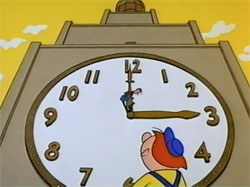 Fix That Clock (Paramount, Swifty and Shorty, July, 1964 – Seymour Kneitel, dir.), is a sort of a dialog-heavy, low budget remake of “Clock Cleaners” – with Swifty and Shorty choosing the same occupation in another huge tower clock – patterned after the Paramount building in Times Square. Dialog is sometimes a little awkward – almost as if Eddie Lawrence wrote the routine for a record, giving verbal descriptions of things we can already see on the screen. Nevertheless, our heroes begin on the hands of the clock face. Swifty asks Shorty what time the clock says. Shorty asks, “Didn’t you look before we got up here?” “I thought you looked”, relies Swifty. Too close to the hands to tell, Shorty climbs down to the bottom of the face and looks up. “It’s either 3:00 or a quarter after twelve”, he shouts. “It can’t be a quarter after twelve”, responds Swifty. “That’s our lunch hour and we’re not eating!” “Well, it can’t be 3:00″, says Shorty – “because my watch says 1:30!” Various acrobatics ensue, with Shorty attempting to reset the huge hands to the correct time. Bracing himself in a trapdoor in the clock face, Shorty’s foot slips through and gets caught in a mainspring, sending the clock’s hands free spinning in opposite directions. By the time they finally succeed in resetting the hands, the master clock on City Hall already reads quarter to two. To avoid climbing the tower again, they push the City Hall clock back to 1:30 as well. Then Shorty realizes that if people realize they worked an extra quarter hour for nothing because of them, “They’ll kill us!” The two attempt a hasty retreat from the second clock face – but get caught in another mainspring, setting City Hall’s clock hands spinning in opposite directions too. As our heroes fall to the sidewalk below, a huge cuckoo bird emerges from the top of the clock face on City Hall – and gets decapitated by the intersecting clock hands, its head falling between our heroes and uttering a final “Cuckoo” for the iris out. Submitted for nomination by Paramount for the Academy Award (?????), but beaten out for a nomination by the studio’s import release from Gene Deitch in Czechoslovakia, Nudnik #2.
Fix That Clock (Paramount, Swifty and Shorty, July, 1964 – Seymour Kneitel, dir.), is a sort of a dialog-heavy, low budget remake of “Clock Cleaners” – with Swifty and Shorty choosing the same occupation in another huge tower clock – patterned after the Paramount building in Times Square. Dialog is sometimes a little awkward – almost as if Eddie Lawrence wrote the routine for a record, giving verbal descriptions of things we can already see on the screen. Nevertheless, our heroes begin on the hands of the clock face. Swifty asks Shorty what time the clock says. Shorty asks, “Didn’t you look before we got up here?” “I thought you looked”, relies Swifty. Too close to the hands to tell, Shorty climbs down to the bottom of the face and looks up. “It’s either 3:00 or a quarter after twelve”, he shouts. “It can’t be a quarter after twelve”, responds Swifty. “That’s our lunch hour and we’re not eating!” “Well, it can’t be 3:00″, says Shorty – “because my watch says 1:30!” Various acrobatics ensue, with Shorty attempting to reset the huge hands to the correct time. Bracing himself in a trapdoor in the clock face, Shorty’s foot slips through and gets caught in a mainspring, sending the clock’s hands free spinning in opposite directions. By the time they finally succeed in resetting the hands, the master clock on City Hall already reads quarter to two. To avoid climbing the tower again, they push the City Hall clock back to 1:30 as well. Then Shorty realizes that if people realize they worked an extra quarter hour for nothing because of them, “They’ll kill us!” The two attempt a hasty retreat from the second clock face – but get caught in another mainspring, setting City Hall’s clock hands spinning in opposite directions too. As our heroes fall to the sidewalk below, a huge cuckoo bird emerges from the top of the clock face on City Hall – and gets decapitated by the intersecting clock hands, its head falling between our heroes and uttering a final “Cuckoo” for the iris out. Submitted for nomination by Paramount for the Academy Award (?????), but beaten out for a nomination by the studio’s import release from Gene Deitch in Czechoslovakia, Nudnik #2.
Head Over Heels, a Sugar Bear episode from Ed Graham’s Linus the Lionhearted television series, features a semi-workable death trap – it we believe that any architect is going to build a giant clock on the face of a building that barely rises over the waterline of a moat. Evil wizard Mervyn ties Sugar Bear’s girlfriend’s hands around the pointer of the minute hand of such clock, and fills a moat below with snapping alligators – so when the clock reaches the half-hour, she’ll be in range of the gators’ jaws. Super strength Sugar Bear to the rescue. Pure corn.
The Brain Drain Game, a 1967 episode of Spy Shadow from DePatie-Freleng’s Super President adventure TV show, briefly uses a cuckoo clock as a death trap. Without explaining its workings, the clock has somehow been modified to reveal and fire a small pistol in place of the cuckoo bird when the hour strikes. The hero, agent Richard Vance, is tied into a chair with special bracing plates placed against his temples so he can’t shift his head, and placed in the clock’s line of fire. How fortunate for him to have an “ace in the hole” – a shadow who, by exercise of mystic powers he learned in the Orient, works independently of himself, and, while impervious to mortal weapons such as bullets, can move objects in the real world and deliver a stunning right cross. The shadow only has to run an impossible distance from a steep mountain road, back into the villain’s compound, and locate our hero in a locked room, all in a matter of less than a minute, to be able to save the day by pushing the chair and our hero aside a split second before the gun’s bullet plants itself in the wall behind. All very probable stuff.
 In the Pink of the Night (DePatie-Freleng/UA, Pink Panther, 5/18/69 – Art Davis, dir.), is the Panther’s own original take on the Porky’s Badtime Story/Early To Bed/The Coo Coo Bird line of bedtime stories. Pink is one of the toughest customers to try to wake up in the morning, as he reflexively reacts with violent methods to any clock’s efforts, without really even being roused from his slumber. Alarm clocks are dealt with by a bureau drawer full of monkey wrenches, which he reaches into to smash the clock, then deposits the crushed remains into another drawer half-full of other similarly crushed timepieces. A clock radio is neutralized by a pair of wire clippers he operates with his toes, severing an electric cord which is held together with multiple pieces of tape and bandages to repair prior severings. And a ringing telephone is dropped by a lever through a trap door, falling upon a pile of other similar phones in the basement. Only a windowshade flipping open and letting sunlight into the room awakens the panther – much too late to catch his morning train to work. At a local shop, he purchases “One Guaranteed Sure Wake Up Cuckoo Clock”. The very-live cuckoo bird emerges the next morning to chime 7:00. Pink repeats his usual motions of attempting to destroy the alarm clock, radio, and telephone while the bird looks on from the wall above. Then Pink realizes the sound is from a new source – and ties a string around the cuckoo’s beak, shoving him back inside the clock, then returns to bed. The cuckoo, somehow freeing himself from the string, tries a new approach. Emerging from the clock, he pushes a heavy safe in the panther’s bedroom to a position over the trap door, and ties the string from one wheel of the safe to the panther’s tail. He starts to cuckoo again, adding to his repertoire the firing of a pair of pistols, the clanging of cymbals, and the blowing of a trumpet. The panther reaches for his trap door lever again – and gets dragged into the basement by the weight of the falling safe!
In the Pink of the Night (DePatie-Freleng/UA, Pink Panther, 5/18/69 – Art Davis, dir.), is the Panther’s own original take on the Porky’s Badtime Story/Early To Bed/The Coo Coo Bird line of bedtime stories. Pink is one of the toughest customers to try to wake up in the morning, as he reflexively reacts with violent methods to any clock’s efforts, without really even being roused from his slumber. Alarm clocks are dealt with by a bureau drawer full of monkey wrenches, which he reaches into to smash the clock, then deposits the crushed remains into another drawer half-full of other similarly crushed timepieces. A clock radio is neutralized by a pair of wire clippers he operates with his toes, severing an electric cord which is held together with multiple pieces of tape and bandages to repair prior severings. And a ringing telephone is dropped by a lever through a trap door, falling upon a pile of other similar phones in the basement. Only a windowshade flipping open and letting sunlight into the room awakens the panther – much too late to catch his morning train to work. At a local shop, he purchases “One Guaranteed Sure Wake Up Cuckoo Clock”. The very-live cuckoo bird emerges the next morning to chime 7:00. Pink repeats his usual motions of attempting to destroy the alarm clock, radio, and telephone while the bird looks on from the wall above. Then Pink realizes the sound is from a new source – and ties a string around the cuckoo’s beak, shoving him back inside the clock, then returns to bed. The cuckoo, somehow freeing himself from the string, tries a new approach. Emerging from the clock, he pushes a heavy safe in the panther’s bedroom to a position over the trap door, and ties the string from one wheel of the safe to the panther’s tail. He starts to cuckoo again, adding to his repertoire the firing of a pair of pistols, the clanging of cymbals, and the blowing of a trumpet. The panther reaches for his trap door lever again – and gets dragged into the basement by the weight of the falling safe!
That evening, the panther boards up the cuckoo’s door, pulls out the clock’s hands, and plugs the resulting hole with a cork. The resourceful cuckoo works with a handsaw against the clock’s back wall, and cuts himself another escape route outside. A knock at the front door arouses Pink in the middle of the night, where he finds the bird performing with noisy musical instruments as a one-man band with a neon sign reading, “WAKE UP”. Pink grabs up the bird, shoves him back in the clock again, and carries the clock to a river bridge, where he drops the clock over the side. A major continuity error is ignored, as the clock floats down the river, despite the fact that the cuckoo sawed a hole in its back in the previous sequence. Panther returns to his home, but is sleepless, as he breaks into a cold sweat, imagining the clock and the bird submerging to the river bottom. He races back to the bridge, ultimately diving in and swimming below the surface in attempt to save the bird – not realizing the bird has used one of the boards nailed to his door as a paddle, and rowed the clock back to shore. While Pink gives up hope, and throws flower petals into the river in memory of his lost companion, the bird drags his clock back to the house, and sets things right again, remounting it on the wall. Pink returns home, sadly creeping into bed – but is surprised to be roused by the cheery call of the cuckoo, which he greets with a relieved smile. He calls a truce with the bird, and the next morning, both of them are sleeping in the same bed together. A new alarm clock on the end table rings. The bird pulls out a giant monkey wrench five times the size of the panther’s, and clobbers the clock. Panther approvingly pats the bird on the head, and they both nod off for a long comfortable doze.
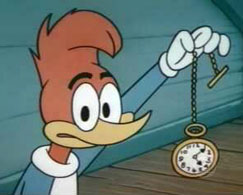
“You are getting sleepy…”
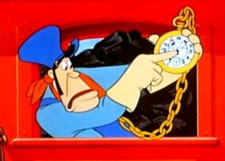 Wristwatches and pocket watches on other occasions have gotten some attention. Black Pete, in Mr. Mouse Takes a Trip (Disney, Mickey Mouse, 11/1//40 – Clyde Geronimi, dir.) displays an unusual train conductor’s pocket watch, depicting instead of normal hands on its face the arms of a railroad track signal, featuring illuminated “stop” and “go” lights to tell him when to call “All Aboard’. Casey Jones, in The Brave Engineer (Disney, 3/3/50 – Jack Kinney, dir.) carries his own pocket watch, which features two moving panels in its background mechanisms – the first rotates in the words “On Time” as he arrives in the wreckage of his engine at the station. A second panel, however, raises in the qualifying language, “Almost”. Woody Woodpecker, in several cartoons of the 50’s such as The Redwood Sap (Lantz/Universal, 10/1/51 – Walter Lantz, dir.) wears a wristwatch obviously manufactured by the same company as Gus Goose’s alarm clock in Donald’s Cousin Gus (1939), which has no numbers but only visual depictions of various meals and an alarm that extends out with a miniature clanging dinner bell. Silly Sidney, in Clown Jewels (Terrytoons/Fox, 10/61 – Dave Tendlar, dir.), discovers a hidden satchel of jewelry that robbers have left in a cave, and becomes a jungle jewelry distributor, himself wearing four wristwatches on his trunk so that he can tell the time of day in four different time zones.
Wristwatches and pocket watches on other occasions have gotten some attention. Black Pete, in Mr. Mouse Takes a Trip (Disney, Mickey Mouse, 11/1//40 – Clyde Geronimi, dir.) displays an unusual train conductor’s pocket watch, depicting instead of normal hands on its face the arms of a railroad track signal, featuring illuminated “stop” and “go” lights to tell him when to call “All Aboard’. Casey Jones, in The Brave Engineer (Disney, 3/3/50 – Jack Kinney, dir.) carries his own pocket watch, which features two moving panels in its background mechanisms – the first rotates in the words “On Time” as he arrives in the wreckage of his engine at the station. A second panel, however, raises in the qualifying language, “Almost”. Woody Woodpecker, in several cartoons of the 50’s such as The Redwood Sap (Lantz/Universal, 10/1/51 – Walter Lantz, dir.) wears a wristwatch obviously manufactured by the same company as Gus Goose’s alarm clock in Donald’s Cousin Gus (1939), which has no numbers but only visual depictions of various meals and an alarm that extends out with a miniature clanging dinner bell. Silly Sidney, in Clown Jewels (Terrytoons/Fox, 10/61 – Dave Tendlar, dir.), discovers a hidden satchel of jewelry that robbers have left in a cave, and becomes a jungle jewelry distributor, himself wearing four wristwatches on his trunk so that he can tell the time of day in four different time zones.
Giants have had an affinity for timepieces also. Paul Bunyan, in “Lumber Jack-Rabbit” (Warner, Bugs Bunny, 9/25/53 – Chuck Jones, dir.) carries a human-sized grandfather clock strapped to his wrist. Elmer Fudd, as a giant in “Beanstalk Bunny” (Warner, Bugs Bunny, 2/12/55 – Chuck Jones, dir.), presses Daffy Duck into service by encasing him in a giant wristwatch, to point at the hours like a Mickey Mouse timepiece. (Daffy comments, “It’s a living.”) Marvin Martian meets the identical fate as a “Mickey Martian” timepiece for an Abominable Snowman in Spaced Out Bunny, a Chuck Jones television episode featured in the special, “Bugs Bunny’s Bustin’ Out All Over”, previously reviewed in my Spacey Invaders IV article on this website.
 And Hanna-Barbera runs with the idea in Secret Squirrel’s Cuckoo Clock Cuckoo (12/11/65). While no writer credits are available, a Secret Squirrel-type examination of the clues points to possible involvement of Michael Maltese. Clue #1: It’s a fairy-tale spoof – a repeated favorite genre of Maltese’s writing, and one of the only such kind in the Squirrel’s episode library. Clue #2: the ending gag, which seems to be a lift again from “Beanstalk Bunny.” Secret Squirrel and Morocco Mole (who appropriately make their appearance at the Chief’s headquarters in two respective clouds of London fog) investigate the disappearance of the innards of Big Ben. Secret describes the perpetrator as someone “rrrrrrrealy big” (imitating Ed Sullivan), and a huge footprint with distinct odors of beanstalk points to a certain well-known giant. Saving lots of labor (and animation) by taking a convenient elevator in the beanstalk trunk (another borrow from Bugs Bunny’s “modern design” in “Jack-Wabbt and the Beanstalk” (1943)), the two secret agents waste no time in arriving at the giant’s castle. Inside, the giant is just installing the workings of Big Ben into his favorite type of timepiece – a giant-sized cuckoo clock. (Did he build it himself or did the old mechanism break down? Otherwise how come the gadget came without its own clockwork already built-in?) After lovingly admiring the cuckoo’s cry, the giant settles down to sleep in a chair below to await the sounding of the next hour.
And Hanna-Barbera runs with the idea in Secret Squirrel’s Cuckoo Clock Cuckoo (12/11/65). While no writer credits are available, a Secret Squirrel-type examination of the clues points to possible involvement of Michael Maltese. Clue #1: It’s a fairy-tale spoof – a repeated favorite genre of Maltese’s writing, and one of the only such kind in the Squirrel’s episode library. Clue #2: the ending gag, which seems to be a lift again from “Beanstalk Bunny.” Secret Squirrel and Morocco Mole (who appropriately make their appearance at the Chief’s headquarters in two respective clouds of London fog) investigate the disappearance of the innards of Big Ben. Secret describes the perpetrator as someone “rrrrrrrealy big” (imitating Ed Sullivan), and a huge footprint with distinct odors of beanstalk points to a certain well-known giant. Saving lots of labor (and animation) by taking a convenient elevator in the beanstalk trunk (another borrow from Bugs Bunny’s “modern design” in “Jack-Wabbt and the Beanstalk” (1943)), the two secret agents waste no time in arriving at the giant’s castle. Inside, the giant is just installing the workings of Big Ben into his favorite type of timepiece – a giant-sized cuckoo clock. (Did he build it himself or did the old mechanism break down? Otherwise how come the gadget came without its own clockwork already built-in?) After lovingly admiring the cuckoo’s cry, the giant settles down to sleep in a chair below to await the sounding of the next hour.
Uncharacteristically, Secret doesn’t use a lot of his patented gadgets in this episode, but spends most of the cartoon scaling the body of the giant with Morocco in mountain-climber fashion, using the giant’s shoelaces for climbing rope. Morocco tries to lasso an upper shirt button – but overshoots his line, catching the giant’s nose instead, and swinging by the rope into his mouth. When the giant pulls him out, Morocco comments “You have a beautiful set of teeth. Who’s your dentist?” Distracted, the giant answers “Why, he has an office down at the…..” This gives Secret and Morocco time to parachute back down on the giant’s handkerchief. Overhearing Morocco remarking about Big Ben, the giant catches on to their objective. “Fee Fi Fo Fum, I’m gonna squish a little crumb”, he rants. But the cuckoo emerges and chimes the hour. The giant stops in his tracks to hear the lovely sound. “What’s so special about ‘cuckoo, cuckoo’?” asks Morocco. The giant pauses, enraptured, and asks Morocco to say that again, stating, “That’s beautiful.” He picks up Secret and offers him a whispered deal, to which Secret cheerily agrees. Big Ben is returned – only because Secret has sold Morocco into slavery, working in the giant’s wristwatch on a cuckoo-bird platform which extends from the watch on the hour. “Secret Squirrel better get me out of this soon, before I go “cuckoo, cuckoo, cuckoo…..” says Morocco for the curtain line.
Unless you know of another way to watch this cartoon for free online – you can check it out for purchase here.
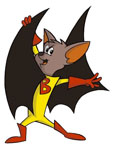 Not so much has been done with sundials or hourglasses, excepting their recurrent use in episodes of early history or pre-history, such as Hanna-Barbera’s “The Flintstones” or “The Roman Holidays”. Goofy’s A Knight For a Day (Disney/RKO, 3/8/46 – Jack Hannah, dir.) features the novelty of a sundial with a sweep second hand. A notable modern-day throwback occurs in Father Time Bomb (Hal Seeger, Batfink, 10/4/67 – Myron Waldman, anim.), one of the few-and-far-between episodes of the “Batfink” series that introduces an original villain. His design will make animation buffs smile – as he looks like a color TV version of Betty Boop’s The Old Man of the Mountain (Animator Myron Waldman obviously demonstrating possession of a long memory). He prefers to do things the old-fashioned way – with a traditional Father Time scythe and the use of hourglasses instead of mechanical clocks. Sneaking into a Police Headquarters locker room through a window, he plants in a locker a time bomb consisting of a small hourglass positioned above a bundle of several sticks of TNT, with a plunger device built into the bottom chamber of the hourglass which will be pushed by the increasing weight of falling sand to detonate the bomb at noon. Making his escape, he telephones the Chief of Police from a phone booth, revealing that he’s Father Time Bomb and that a bomb will go off somewhere in the city at noon, but not disclosing the location. He adds, “The reason I’m telling you this is so no one else gets the credit!”
Not so much has been done with sundials or hourglasses, excepting their recurrent use in episodes of early history or pre-history, such as Hanna-Barbera’s “The Flintstones” or “The Roman Holidays”. Goofy’s A Knight For a Day (Disney/RKO, 3/8/46 – Jack Hannah, dir.) features the novelty of a sundial with a sweep second hand. A notable modern-day throwback occurs in Father Time Bomb (Hal Seeger, Batfink, 10/4/67 – Myron Waldman, anim.), one of the few-and-far-between episodes of the “Batfink” series that introduces an original villain. His design will make animation buffs smile – as he looks like a color TV version of Betty Boop’s The Old Man of the Mountain (Animator Myron Waldman obviously demonstrating possession of a long memory). He prefers to do things the old-fashioned way – with a traditional Father Time scythe and the use of hourglasses instead of mechanical clocks. Sneaking into a Police Headquarters locker room through a window, he plants in a locker a time bomb consisting of a small hourglass positioned above a bundle of several sticks of TNT, with a plunger device built into the bottom chamber of the hourglass which will be pushed by the increasing weight of falling sand to detonate the bomb at noon. Making his escape, he telephones the Chief of Police from a phone booth, revealing that he’s Father Time Bomb and that a bomb will go off somewhere in the city at noon, but not disclosing the location. He adds, “The reason I’m telling you this is so no one else gets the credit!”
The call for help goes out to Batfink. Of course, Batfink knows the city directory like the back of his wing, and Father Time Bomb has a registered mailbox at an easily located residence address. Only problem is he lives in a solid Plutonium bomb shelter. Even Batfink’s Asiatic sidekick Karate can’t break down the door. But the residence is hardly impervious to entry, having two conveniently obvious alternative entrances – a small metal chimney big enough for Batfink to fit, and a delivery chute connected to a sort of elevated storage silo. Batfink chooses the chimney, and enters. Father Time states he’ll never “do time”, and raises his scythe. Batfink alters his usual line: “Your scythe cannot harm me. My wings are like a shield of steel.” Father time is unimpressed – “Who’s gonna clip your wings?” he replies, and cuts a rope with the scythe, dropping a heavy sandbag on Batfink’s head from above to knock him out. We fade to Batfink, unconscious, encased in the bottom chamber of a large hourglass. Father Time remotely opens a hatch on the storage silo outside, which sends a steady flow of sand pouring down the chute into the upper hourglass chamber, and gradually into Batfink’s half, until Batfink is neck deep and about to be smothered. Outside, Karate notes that noon is rapidly approaching, and decides he must enter and alert Batfink. He chooses the larger entrance of the delivery chute, and slides in atop the sand. Landing in the upper chamber of the hourglass, Karate’s bottom blocks the flow of sand through the hourglass stem, giving Batfink time to revive. Batfink breaks through the glass with his wings, and handcuffs are placed on Father Time Bomb. Batfink announces he’ll be taken to Police Headquarters to be forced to reveal the bomb’s location. “No! Take me anywhere but there!” replies Father, and reveals that’s just where the bomb is. Batfink arrives in the nick of time and disarms the device. Hearing that Karate saved Batfink’s life, the Chief congratulates Karate on using his head. “But I didn’t use my head”, replies Karate, remembering in visualization the part of him on the other end he really used to save the day.
One of the longest projects to highlight Father Time and the New Year season was Rankin-Bass’s, Rudolph’s Shiny New Year (12/10/76), a stop-motion sequel to the studio’s blockbuster, Rudolph the Red-Nosed Reindeer (1964). They tried hard – with a sterling vocal cast including Red Skelton, Frank Gorshen, Morey Amsterdam, Hal Peary, Paul Frees, Don Messick, and the original Rudolph (Billie Richards), and came up with some creative and elaborate visuals and design concepts. But somehow, the special just didn’t click to become a classic. Perhaps it hurt some that a redesigned Rudolph was short on antlers and too round in the face – and just didn’t look as universally appealing as the original. Perhaps it seemed a little too lonely for Rudolph in some places in the script, as he gets saddled with the task of largely going it alone to search through a harsh winter landscape for a lost Baby New Year to keep time from standing still. (I mean, couldn’t Hermie the elf or Yukon Cornelius have taken a little time off from their dentistry practice and peppermint mine to offer him a bit of moral support?) Father Time (Red Skelton) plays narrator and instructor to Rudolph in his search, meeting with Rudolph in his castle on the other side of a desert consisting of the Sands of Time. His assistants include a “Clockwork Soldier” (a sort of living alarm clock who speaks in rhyme), and a transportation camel whose hump is also built like a mantel clock. (Some of this sequence plays more like something out of an Oz book, bringing back memories of clockwork robot Tik Tok). The Baby New Year (who has gone missing because he is ashamed of his big ears (shades of “Dumbo”)) is hiding in an archipelago of magical islands where past Father Times go after their year in reign has expired – special worlds where time stands still and everything is as it was in the year over which they presided. Pursuing the Baby and Rudolph is a giant buzzard named Eon – another time creature, for whom his eon of existence is about to expire – unless he can keep the Baby New Year from taking the throne, thus preventing the occurrence of the date on which Eon’s existence will end. It’s complicated, and feels considerably forced, unlike the more natural flow and sympathetic simplicity of the previous special. While it provides decent entertainment for the kiddies, and still gets seasonal cable TV air dates, the film wasn’t even considered special enough to rank its own DVD, and had to settle for “bonus extra” status on discs of “The Year Without a Santa Claus”. I wonder if the studio ever really felt they’d decently recouped their probably substantial investment in vocal and creative talent in the years after this special was made. Creative accountants probably wrote about this one in holiday red ink.
The Coo Coo Clock Caper (10/19/83), an episode of Inspector Gadget, centers around a Swiss clockmaker hired by Dr. Claw to tamper with a vault time lock to permit a raid on the Swiss gold reserve, then his assistance in using his clock factory to mold giant metal gears out of the gold to permit their hiding or smuggling. As for Gadget, the clockmaker devises a wristwatch which he presents the meddlesome detective with, equipped with an electronic device to set off all his gadgets in haywire fashion every hour on the hour. Gadget survives several malfunctions, and returns to the clockmaker for a check-up on what’s causing their unpredictability. Alerted by Dr, Claw of Gadget’s return, the clockmaker pretends to have a sure way to test the gadgets out. An assistant bolts Gadget’s extendable arms, legs, and neck to five different gears on the large tower clock of the clockmaker’s factory, then the clockmaker sets the gears in motion. Even if he is semi-robotic, this episode really “stretches a point” in credibility as not only Gadget’s limbs, but even his neck, wind around and around the gears’ axles, with Gadget somehow still alive through the ordeal, and as usual oblivious to the fact it’s a trap. But the clockmaker forgets the hour is nigh – and Gadget’s contraptions again go off uncontrollably. His coat inflates, disrupting the axles. His hat hammer starts smashing wildly at the gears. The stress on the entire tower causes it to crack, crumble, and fall apart into the street. Gadget of course gets free, and the gold gears are spilled into the street for Chief Quimby and the police to plainly see. Dr. Claw will just have to plot to get Gadget “next time.”
The Mad Tea Party (1983) is an episode from an obscure Anime adaptation from Lewis Carroll’s Alice in Wonderland, made as a TV series, (“Fushigi no Kuni no Alice”), which really isn’t bad at all. It was a collaboration between Japan and Germany (Wow! Is the axis re-forming?) , and seems to have had very little exposure in the U.S. This installment involves an extended visit with Father Time, as Alice, the Mad Hatter and March Hare attempt to investigate the stoppage of all of Wonderland’s clocks. Several sequences are quite elaborate for a TV budget, with massive gearworks and walls of clocks in Father Time’s castle and in a time substation inside a giant pocket watch in space. Father Time finally deduces who is most likely to be the culprit – Jabberwocky – the only creature ugly enough to have a face that could stop a clock. Jabber indeed takes credit for the crime, having done it in revenge for clocks always waking him up when he wants to sleep in on Sunday. Father Time uses a little magic to render the beast harmless to chronology – by “taking a few years off him” with a magic hourglass – reducing him to a toddler who is just too cute to stop clocks anymore.
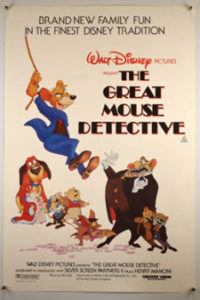 The Great Mouse Detective (Disney, 7/2/86), the first Disney feature to tout the use of a computer-assisted animation sequence, presents a striking climax, as Professor Ratigan’s airship crashes through the transparent facing of Big Ben, with passengers Ratigan, a small child-mouse hostage, and Detective Basil of Baker Street thrown inside the tower. Basil awakens in a dizzy state, as he is standing upon a slowly turning giant clock gear. Behind him looms Ratigan on another gear, with the child struggling to utter a warning to Basil. Basil gets socked into the lower reaches of the massive clockworks, while the child finds herself standing on a massive gear tooth, headed for intersection with another interlocking gear (reminiscent of the gear tooth crushing threat in Disney’s Academy Award winner “The Old Mill” from 1937). Basil releases a stop catch that sets loose a large chain, spinning over a pulley toward the top of the tower. Hanging on to a chain link, Basil is lifted up to the level of the child’s gear, grabbing her out of harm’s way just as the gears intersect. Ratigan erupts in a rage as Basil and the child run for the hole in the clock face, and pursues them in a wonderfully detailed maze of gears and machinery, painted in dark and sinister hues and backlit by lightning from an outside storm, as all semblance of “humanity” disappears from the character and he is revealed in the shadows as a true and hideous rat. Outside, Basil struggles to lift the child within reach of her father and Basil’s partner Dawson in a waiting balloon.
The Great Mouse Detective (Disney, 7/2/86), the first Disney feature to tout the use of a computer-assisted animation sequence, presents a striking climax, as Professor Ratigan’s airship crashes through the transparent facing of Big Ben, with passengers Ratigan, a small child-mouse hostage, and Detective Basil of Baker Street thrown inside the tower. Basil awakens in a dizzy state, as he is standing upon a slowly turning giant clock gear. Behind him looms Ratigan on another gear, with the child struggling to utter a warning to Basil. Basil gets socked into the lower reaches of the massive clockworks, while the child finds herself standing on a massive gear tooth, headed for intersection with another interlocking gear (reminiscent of the gear tooth crushing threat in Disney’s Academy Award winner “The Old Mill” from 1937). Basil releases a stop catch that sets loose a large chain, spinning over a pulley toward the top of the tower. Hanging on to a chain link, Basil is lifted up to the level of the child’s gear, grabbing her out of harm’s way just as the gears intersect. Ratigan erupts in a rage as Basil and the child run for the hole in the clock face, and pursues them in a wonderfully detailed maze of gears and machinery, painted in dark and sinister hues and backlit by lightning from an outside storm, as all semblance of “humanity” disappears from the character and he is revealed in the shadows as a true and hideous rat. Outside, Basil struggles to lift the child within reach of her father and Basil’s partner Dawson in a waiting balloon.
But Ratigan charges – knocking Basil down to one of the clock hands but inadvertently causing the child to be thrown into the air where she is caught by her father. Now Ratigan turns his attentions to Basil, pouncing ahead of him at every turn and announcing that there’s “no escape”. Baring for the first time his razor sharp rodent claws, Ratigan slashes at Basil, tearing his clothing and shredding his fur. Basil teeters weakly at the end of one of the clock’s hand, and a final blow from Ratigan sends him sailing over the edge. Ratigan, who has literally burst through his own clothing in his raging fit, now bare chested in a coat of rat fur, takes a several-second pause before his rage can subside enough to let him drink in the situation, then shouts for all to hear that “I’ve won!” Until he hears what he believed he would never hear again – the sound of Basil’s voice far below, where he clings to remnants of the tail section of Ratigan’s wrecked airship. “The game’s not over yet”, Basil declares. Above them, the clock’s minute hand clicks to the number 12. The reverberation of the clock chimes is deafening, and violently vibrates Ratigan right off the other clock hand. He plummets, but grabs at Basil – causing the tail-prop mechanism of the airship to disconnect and fall with the two of them down through the fog to what appears certain doom. The child cries in the arms of her father – until a faint whirring sound is heard below. Rising from the fog comes a propeller. Basil has caught the airship tail prop, and is pedaling it like a one-man helicopter. A cheer goes up from Dawson, the child and her father, and the scene fades, as all is well.
One Minute Till Three, the first of three cartoons in Tiny Toon Adventures’ Best o’ Plucky Duck Day (11/21/90), has Plucky as a hapless student in a computer animation class presided over by Granny (of Tweety and Sylvester). It’s Friday afternoon, and Plucky is daydreaming of having the whole weekend to goof off. Until his dreams transform into a nightmare, as Granny decides to fill the last few minutes of the day by randomly fielding questions to her students to see what they’ve learned – then bombard them with assignments to complete term papers of ever-growing page length by Monday if they give incorrect answers. Plucky instantly panics, realizing he’s paid so little attention, he doesn’t even remember what class he’s in. His ray of hope is that the clock appears to have only one minute to go before the bell rings and he’s free. But, in almost direct homage to Van Buren’s “Croon Crazy”, discussed in an earlier installment of these articles, the clock repeatedly malfunctions, its minute hand falling backwards to let more and more minutes elapse. Granny’s questioning seems to be drawing closer and closer – and the page count of each assigned paper going up by the thousands. Daffy tries every means possible to distract Granny to call on others besides himself, but questions finally come straight down his row of desks, until there is no escape. The clock still refuses to cooperate. Granny asks Plucky for what appears to be a ridiculously incomprehensible calculation. “I’m dead”, Plucky thinks to himself. Making a last attempt to stall (which Granny sees through), Plucky finally resorts to begging for mercy. “It’s Friday afternoon! Class is almost over!” “Your answer, please”, demands Granny. “Aw geez, Granny, it’s 2:59!”, pleads Plucky. “259? Why that’s absolutely correct!”, replies a pleased Granny. The clock finally reaches 3:00, with Gogo Dodo emerging from it to chime “Cuckoo”. Plucky joins in with a demented series of “Cuckoos”, and faints on the spot.
Tiny Toon Adventures also did a whole tribute to the school clock as the opening to their direct-to-video movie How I Spent My Summer Vacation (1993) – sing along with this:
“The Clock King” (9/21/92) and ”Time Out of Joint” (10/8/94) provide the first animated adventures of villain Clock King in Batman: The Animated Series. They are actually somewhat weaker than the highest caliber episodes of the series, the first featuring a supposed death-trap for the mayor tied to the hands of a tower clock that really doesn’t make sense – how can the hands of a clock “come together” to kill a victim tied to the lower one, when everyone knows they’d be mounted at different distances from the clock face to allow them to pass on each revolution? The second really doesn’t feature clocks per se, but a professor’s high-tech device for speeding or slowing relative time by quantum physics – allowing the Clock King to zip in unseen to commit crimes while the world around him seems to stand still. Both shows register somewhat implausibly -probably explaining why the writers didn’t expand the character’s use to further episodes. The King would make additional comebacks in episodes sharing the spotlight with other villains in “Justice League Unlimited” and “Batman: The Brave and the Bold” – which are beyond the patience of this writer to wade through.
 “The Late Donald Duck” (9/18/96), an episode of Disney’s Quack Pack, deals with the old storyline of being chronically late to work, rooting back to Porky’s Badtime Story. It also presents one of the few scripts of the series that doesn’t get lost on side-stories about Daisy or the nephews, and centers on Donald himself, in the manner of an extended-length theatrical short. Late again to his work as a TV news cameraman, Donald arrives to work on crutches, and all bandaged up (including a large bandage around his bill, giving the writers a storytelling excuse to avoid Donald’s natural speech impediments by having him hand his boss, egotistical reporter Kent Powers, a multitude of handwritten excuse notes, then endless computer-paper printouts, for Kent to read aloud as a de facto narrator to the events of the morning). According to his tale of woe, Donald actually got to work early, but was sidetracked by the impulse to offer his assistance to a small boy trying to get a letter into a mailbox. (In flashback to the “real” events, Donald’s “generosity” is really motivated by him asking the question, “What’s in it for me?”, and the kid bribing him with offer of a five dollar bill.) A breeze blowing the letter out of his hand starts Donald on an endless series of misadventures. Getting hit head-on in traffic. Chasing the letter down from a scavenger crow, and being catapulted from high tension wires head first into the mailbox.
“The Late Donald Duck” (9/18/96), an episode of Disney’s Quack Pack, deals with the old storyline of being chronically late to work, rooting back to Porky’s Badtime Story. It also presents one of the few scripts of the series that doesn’t get lost on side-stories about Daisy or the nephews, and centers on Donald himself, in the manner of an extended-length theatrical short. Late again to his work as a TV news cameraman, Donald arrives to work on crutches, and all bandaged up (including a large bandage around his bill, giving the writers a storytelling excuse to avoid Donald’s natural speech impediments by having him hand his boss, egotistical reporter Kent Powers, a multitude of handwritten excuse notes, then endless computer-paper printouts, for Kent to read aloud as a de facto narrator to the events of the morning). According to his tale of woe, Donald actually got to work early, but was sidetracked by the impulse to offer his assistance to a small boy trying to get a letter into a mailbox. (In flashback to the “real” events, Donald’s “generosity” is really motivated by him asking the question, “What’s in it for me?”, and the kid bribing him with offer of a five dollar bill.) A breeze blowing the letter out of his hand starts Donald on an endless series of misadventures. Getting hit head-on in traffic. Chasing the letter down from a scavenger crow, and being catapulted from high tension wires head first into the mailbox.
The kid using Donald’s old trick from Modern Inventions (1937) by tying a string to the $5.00 bill, then running away with it. Falling down a sewer for an encounter with rats and an albino alligator. Being washed out of a drain onto the launching area of the Space Shuttle, and blasted into space. Battling elephantine space aliens. Falling into a black hole, and emerging via time warp into the prehistoric past. Being frozen in an iceberg, and only thawed out this morning, Arriving back in Duckburg only to have to battle the space aliens again. And finally making it to work in his battered condition. The story has Kent rolling on the floor in laughter, stating that someone ought to make a movie of this – or better yet, a cartoon! But despite the laughs, he takes sadistic glee in announcing to Donald that he’s fired. Until Daisy shows up, asking what the two of them are doing here so early. “Isn’t it 9:30?”, asks Kent. “No, it’s 8:30″, as Daisy reminds him that daylight saving time just kicked in. An embarrassed Kent realizes he no longer has grounds to fire Donald, and sheepishly makes as graceful an exit as he can into his trailer. Daisy consoles Donald while maintaining her skepticism, asking how Donald expected Kent to believe such a tale. Out in space, the commander of the elephant aliens, monitoring the events on a screen, expresses puzzlement and a twinge of respect for a fellow warrior, realizing the Earth creatures will never believe or know of the exploits of the hero who saved them – Donald Duck.
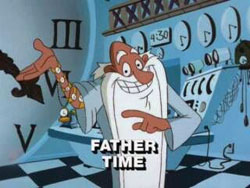 Perhaps the most recent gig for Father Time was Steven Spielberg’s Hysteria (1998-2000) – an overly and intentionally educational series that tried desperately to mix Animaniacs -style wackiness into each week’s history lesson – but never quite caught on. Father Time (voiced by Frank Welker) takes primary duties as guide through the ages, but unfortunately has to share suck tasks with the unlikable “brat” Big Fat Baby, a ditzy tour guide named “Miss Information”, and a bevy of totally forgettable kid characters (with personalities less memorable than “The Funny Company”) I believe several factors besides the lack of winning supporting personalities contributed to the show’s downfall. Its pace was too frenetic to sit through comfortably – and its writers displayed a lack of patience, too, never developing any segment into traditional cartoon length of six, five, four, or rarely even three minutes – but instead ping-ponging all over the place between topics, never letting any idea develop beyond more than a couple-minute skit. Freakazoid had experimented with such techniques – but generally let at least two segments in a show run at normal length, so we didn’t go away totally unsatisfied. Perhaps Spielberg envisioned the show as a sort of educational “Rowan and Martin’s Laugh-In” – but that kind of comedic lightning rarely strikes twice. I tried to follow the show when it first premiered – but found myself tuning out after a mere handful of weeks.
Perhaps the most recent gig for Father Time was Steven Spielberg’s Hysteria (1998-2000) – an overly and intentionally educational series that tried desperately to mix Animaniacs -style wackiness into each week’s history lesson – but never quite caught on. Father Time (voiced by Frank Welker) takes primary duties as guide through the ages, but unfortunately has to share suck tasks with the unlikable “brat” Big Fat Baby, a ditzy tour guide named “Miss Information”, and a bevy of totally forgettable kid characters (with personalities less memorable than “The Funny Company”) I believe several factors besides the lack of winning supporting personalities contributed to the show’s downfall. Its pace was too frenetic to sit through comfortably – and its writers displayed a lack of patience, too, never developing any segment into traditional cartoon length of six, five, four, or rarely even three minutes – but instead ping-ponging all over the place between topics, never letting any idea develop beyond more than a couple-minute skit. Freakazoid had experimented with such techniques – but generally let at least two segments in a show run at normal length, so we didn’t go away totally unsatisfied. Perhaps Spielberg envisioned the show as a sort of educational “Rowan and Martin’s Laugh-In” – but that kind of comedic lightning rarely strikes twice. I tried to follow the show when it first premiered – but found myself tuning out after a mere handful of weeks.
5 – – 4 – – 3 – – 2 – – 1 – – We’re outta time! Happy New Year, everybody! We’ll ring in the new year with some wintery fun next week.


 Charles Gardner is an animation enthusiast who toils by day as a member of LA Law – but by nights and weekends indulges in classic jazz and ragtime as a performer; and studies classic Hollywood cartoons… maybe a little too much.
Charles Gardner is an animation enthusiast who toils by day as a member of LA Law – but by nights and weekends indulges in classic jazz and ragtime as a performer; and studies classic Hollywood cartoons… maybe a little too much.


































































































































































A few late-discovered clock extras have also included Timon and Pumbaa’s “Swiss-Missed” (9/29/95), in which the meerkat and warthog inexplicably visit Switzerland in search of rare chocolate-covered bug truffles, but wind up attempting to spread their “Hakuna Mutata” philosophy to an overworked clockkeeper in charge of the village’s giant cuckoo clock. They coax the keeper to hit the slopes, take a vacation, and learn how ro kiss a girl. But no sooner does he leave than the clock’s inner workings go kaplooey, and the Roman numeral V falls off and almost crushes our heroes. Hearing that the regional timekeeping supervisor will fire the clockkeeper if the clock doesn’t strike 12, Timon and Pumbaa try to make a fast getaway at the railway station. A sign on the ticket booth says “Back in 5 minutes” – but since everyone relies on the now malfunctioning master clock, no one comes back! Our heroes thus do the right thing, and hit the slopes on skis to locate the clockkeeper. They finally retrieve him with only two minutes to spare, but he realizes there’s no way to repair the clock in time. Timon and Pumbaa pinch-hit to save him his job, with Pumbaa dancing in drag as one of the clock’s animated figures, and Timon doubling as the cuckoo bird.
“Yodel Recall” (9/14/96), from the Sylvester and Tweety Mysteries, involves Granny’s investigation of the kidnaping of the Von Trump family singers (who, having advanced to middle-age, have faked their own kidnaping as a publicity stunt and to collect a tidy ransom to boot). Granny and Hector wind up tied to a giant cuckoo clock surrounded by dynamite, with a fuse to be lit from the emergence of the cuckoo bird on his platform. The Abominable Snowman (from Bugs Bunny’s The Abominable Snow Rabbit) guest stars as red herring suspect #1, and collides with the clock on his abominable snowmobile, for a wild chase finale.
“No Time For Love” (11/2/96), a one-shot episode from Animaniacs, is a direct successor to Paramount’s The Bored Cuckoo. A wooden cuckoo bird has eyes for the live female canary in a cage next to his clock. He tries to woo her with candy and flowers – even serenades her with a miniature grand piano in a kind of cross between Liberace and Elton John – but every time he starts making progress, his clock platform yanks him back into the clock until the next hour. He appears in top hat and tuxedo, and pops the question with an engagement ring. The canary responds with a bridal veil, and a picture of a minister on the newspaper clippings lining her cage. But before he can kiss the bride, the platform does it to him again. Now determined to sever himself from the clock, the cuckoo tries various drastic measures: riding a jet-propelled vehicle dressed as Evel Knievel. Dressing as Patton and trying to blow the platform off with a hand grenade. Lassoing the clock hands like a cowboy, while applying hacksaws, jack hammers and blowtorches to the platform extender. Nothing will destroy the platform. But the canary observes the obvious – she merely lifts him up off the platform, to which he’s not even physically connected! But in the process, she gets yanked back into the clock in place of him. The cuckoo bemoans his lost love for the next hour in her cage – but she reappears on the platform on the striking of the hour, and embraces him – to drag him back into the clock too. The cuckoo emerges from his doors to yank the hands off the clock face – as there’s no good reason for him to come out of this cozy setup again!
Finally, there is Disney’s computer-animated short, Tick Tock Tale (2010). This one never received a theatrical release (originally scheduled to be issued with “Tangled”), and waited until the Disney Short Films Blu-Ray/DVD to see the light of day. It really isn’t much, although the graphics feel like they could have easily been reworked as the never-made visual to accompany the records “Tickety Tock” or “The Clock That Went Tock-Tick”, discussed previously. A little clock, on 75% discount for always running slow, foils a robbery of a British clock store by chiming and cuckooing when the robber hits the street. Before running from the approach of a Bobby, the robber stomps on the little clock with his foot. The shop owner drops the remains of the little clock in a wastebasket – but the grandfather clocks retrieve him with their pendulums and place him on a work table, together with a flyer bearing the shop’s work motto: “No repair too small”. Surprised at discovering these items, the owner finally sits down and repairs the little clock properly. In the closing shot, a grandfather clock helps the now repaired little clock by resetting his hands ahead to the proper time, for a happy fade-out.
The synopsis for “Cuckoo Magoo” sounds like a rehash of the theatrical short “The Explosive Mr. Magoo”, in which he buys a windup toy thinking it’s a clock while on the way to complain to the newspaper, and is mistaken for a bomber. That one has a gag involving a clock tower, with Magoo stepping out a window thinking it was the elevator and stepping on the second hand, bragging to the inexistent elevator operator about how he made his bosses “eat crow, humble pie.” When the hand tilts too far and Magoo falls, he thinks the operator is a “company man” giving him a rough ride. He lands safely on the awning below.
Also – you forgot to mention the Futurama episode “Xmas Story” where Fry is hanging from a clock tower, the twist being that it’s a digital clock and he’s hanging on to the LED display. (How? Because it’s the future!) First he’s hanging on to the top of a two in the last digit, and is fine as it changes to a three, but when it becomes four, the top section disappears and Fry grabs the middle section; he’s safe again through five and six, until it reaches seven… and falls.
I’m with you on “Hysteria”. It was the only Spielberg/Warners collaboration I didn’t like — that, and when they teamed Elmira with Pinky and the Brain.
The melody of that Tiny Toons song comes from the Spinnliedchen (“Spinning Song”) by Albert Ellmenreich, familiar to all piano students and seldom played by anyone over the age of ten.
The decapitated cuckoo in “Fix that Clock” reminds me of the Edgar Allan Poe short story “A Predicament” (or, “The Scythe of Time”), in which the narrator, “Signora Psyche Zenobia”, climbs a clock tower to enjoy the view but is trapped and ultimately decapitated by the clock’s minute hand. It’s a parody of stories like “The Pit and the Pendulum” and “The Premature Burial” — first-person accounts of a gruesome slow death — as well as a jab at pretentious female writers; and like most of Poe’s attempts at humour, it’s unfunny and mean-spirited. To my knowledge it’s never been made into a cartoon and probably never will be.
The organ grinder’s waltz in that same cartoon is from the Johann Strauss operetta “Die Fledermaus” (“The Bat”), whose plot, broadly speaking, concerns a hero in a bat costume who puts wrongdoers in jail, but otherwise has nothing in common with DC’s caped crimefighter. I don’t know if the boys at Paramount were making a musical joke about having bats in one’s belfry, but I wouldn’t put it past them.
That must be the only Batfink episode in which his Supersonic Sonar Radar doesn’t help him.
Spy Shadow — that’s got to be Ted Cassidy, right?
I could be wrong, here, but didn’t “THE BEANY AND CECIL SHOW” contain an episode called “Beany and the Jack Stalk” with one minor clock gag? I can’t lay my hands on it quite yet, but it appears on the fifth VHS volume of the classic show, the very first cartoon if those who still have all their cherished VHS volumes want to do the research. Happy New Year, all. Here’s to more classic cartoons revealed in 2020.